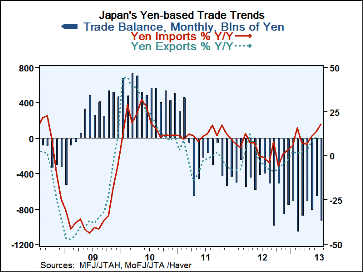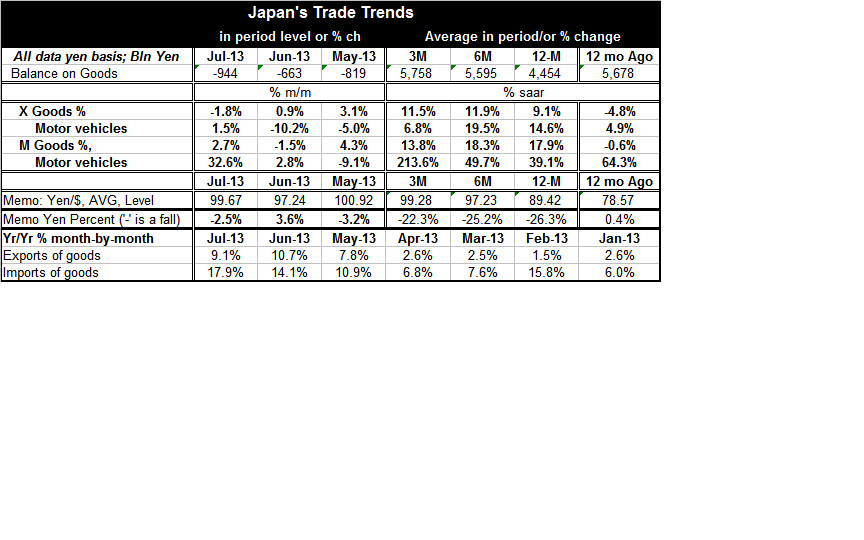 Global| Aug 19 2013
Global| Aug 19 2013Japan's Trends Twist and Turn
Summary
Japanese goods exports fell by 1.8% July as imports of goods surged by 2.7%, widening Japan's trade deficit on the month. Year-over-year exports are growing at a 9.1% annual rate as imports surge at a 17.9% annual rate and as oil [...]
 Japanese goods exports fell by 1.8% July as imports of goods surged by 2.7%, widening Japan's trade deficit on the month. Year-over-year exports are growing at a 9.1% annual rate as imports surge at a 17.9% annual rate and as oil imports are playing a big role in Japan's trade as it has shut-down its nuclear capability and is dealing with the issues related to the Fukushima nuclear disaster.
Japanese goods exports fell by 1.8% July as imports of goods surged by 2.7%, widening Japan's trade deficit on the month. Year-over-year exports are growing at a 9.1% annual rate as imports surge at a 17.9% annual rate and as oil imports are playing a big role in Japan's trade as it has shut-down its nuclear capability and is dealing with the issues related to the Fukushima nuclear disaster.
Within the year goods imports are not building momentum; six- and twelve- month annualized import growth rates of 18% dropped to about a 14% annual rate growth rate over three months. Exports are advancing by 9.1% year-over-year and now are up and an 11% to 12% rate over three months and six months.
12-months to 3-months there has been a substantial weakening of the yen; but from six months to three months there is only a small weakening of the yen.
Japan continues to be economically challenged. The Abe government has declared the end to its deflation arguing that Japan has turned the corner and that now Japan will grow in the period ahead; the episode of falling prices is behind it. Even so, Japan faces tremendous challenges with the policy focus right now on whether Japan is going to implement a substantial consumption tax hike to deal with its huge debt problems or whether will have to modify the program that is in train. Raising taxes, of course, will make it more difficult for Japanese economy to grow and growth makes dealing with high debt easier; therein lies Japan's dilemma.
Japan also has a population growth problem as it is confronted with the reality of a shrinking population. However, recently there are some efforts afoot to try to create incentives to increase family formation. Japan needs to do something because it has completely redlined the notion of increasing immigration to solve its shrinking population problem. Unless it does something to boost population growth it's hard to see how Japan is going to be able to deal with it huge ratio of debt to GDP without having significant problems.

Robert Brusca
AuthorMore in Author Profile »Robert A. Brusca is Chief Economist of Fact and Opinion Economics, a consulting firm he founded in Manhattan. He has been an economist on Wall Street for over 25 years. He has visited central banking and large institutional clients in over 30 countries in his career as an economist. Mr. Brusca was a Divisional Research Chief at the Federal Reserve Bank of NY (Chief of the International Financial markets Division), a Fed Watcher at Irving Trust and Chief Economist at Nikko Securities International. He is widely quoted and appears in various media. Mr. Brusca holds an MA and Ph.D. in economics from Michigan State University and a BA in Economics from the University of Michigan. His research pursues his strong interests in non aligned policy economics as well as international economics. FAO Economics’ research targets investors to assist them in making better investment decisions in stocks, bonds and in a variety of international assets. The company does not manage money and has no conflicts in giving economic advice.






